As an individual of African descent, oral history has always been present in my life. Listening to the words of my grandparents, paired with black and white, much treasured images, is how I have learnt much of the history of my ancestors. However, it is not something that I associate with the other side of my hyphenated identity, the British part. That history is one that I learnt in the classroom, in history books, in museums.
Because of this I have always seen European history as something distant; as Henry VIII and his 6 wives, as Victorian cotton-mills, as the evacuees of World War II. This is until recently, when I was introduced to a small group of East Londoners who enlightened me to the fact that these histories are not distant but, in fact, a very real part of our collective past, active present and prospective futures.
Similar to my grandparents, these residents have stories that, when shared, have the potential to teach others not only about themselves, but also about their communities. A power that they are realising through a new mobile phone app called 'In My Footsteps.'
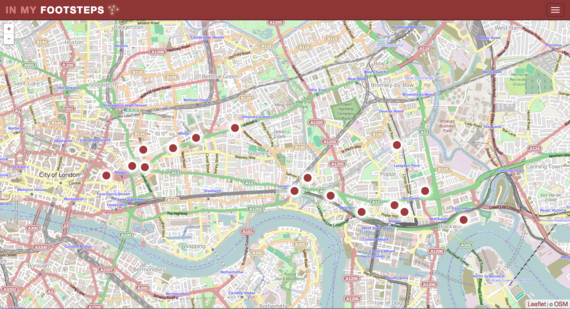
All photographs courtesy of www.inmyfootsteps.org
Altogether 16 residents - from Whitechapel, Poplar and Limehouse, representing a diverse range of age, cultures and ethnic backgrounds - have worked together with museums, local historians, and community groups, to create local walking tours that are shared through the app.
Creative Producer, Marion Vargaftig, explains: "At the heart of the project was working with the local community; for them to have a say in how the history of the areas in which they live are viewed and interpreted."
Each participant shares his or her memories through anecdotes that are brought to life with video, archive maps and photographs. This unique approach allows app-users not only to gain an insight into personal histories, but also to learn how these histories interact with their local area. By allowing users to literally walk in the storytellers' footsteps, past the familiar buildings and landmarks they pass everyday, it affords them the opportunity to re-evaluate their surroundings. It brings history to life.
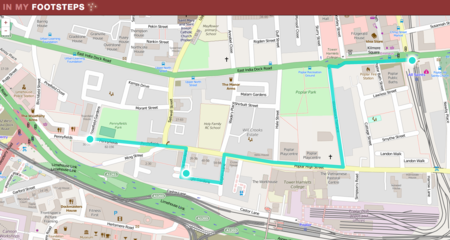
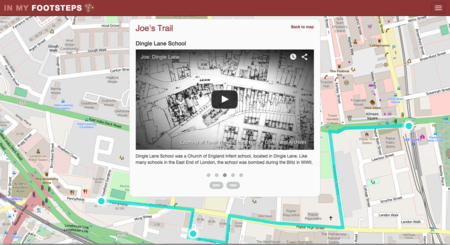
Joseph Hassan, an 84-year-old from Poplar, uses his trail to retrace his last walk through the streets of East London on the way to being evacuated in August 1939. You can follow Joe's trail here: http://inmyfootsteps.org/#r23s0
"I think a lot of what young people learn about in schools tends to be a bit distant from them. So they'll learn about kings, they'll learn about queens, they'll learn about famous people who have done wonderful things throughout history, but what I think is important about this is that it shows that history can be created by very ordinary individuals. That they can create history, that their parents, their grandparents, have all got historical stories to tell and that that is history in the making."
Debbie Weekes-Bernard, who has used the app to design teaching resources for school pupils told me,
"It's a really good way to get young people to talk about really thorny issues, like migration, like change, like progress and I think it will be a really good tool for teachers in getting young people switched on to subjects, like history and geography, in a way that's immediately relevant, locally relevant, and gets them to appreciate the areas that they live in a bit more."
And this is very much at the heart of what the residents aim to do: "I've learnt so much since being involved with In My Footsteps," shared fifteen-year-old Milanda Brown, the projects youngest participant, "about places, statues and symbols around Poplar that I'd never acknowledged before. So the main aim of my trail is to help other people my age to realise and appreciate the things that are around them."
A sentiment that is almost identical to that of participant Laurie Allen, who has lived in the East End of London for 70 years: "This is the opportunity for young people to recognise what the old went through, but not in a condescending way, just to bring gently to their equation. We just want to share a little bit about the past and how it were so that they can appreciate what they have and how it is today."
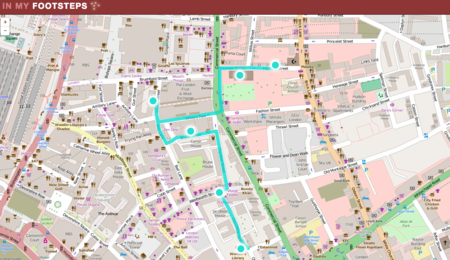
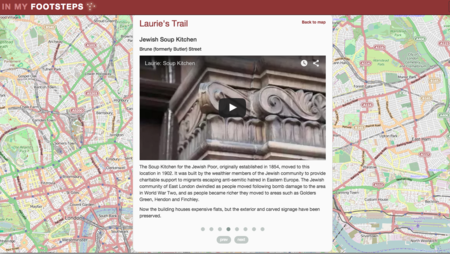
A section of Laurie's trail that details his experience of the Jewish Soup Kitchen in Whitechapel. View Laurie's trail here: http://inmyfootsteps.org/#r23s0
Through speaking to Laurie, I learnt how the app is also acting as a tool through which to discuss the rapidly evolving landscape of the East End of London:
"As time has moved on, the East End is now being recognised as a desirable place to live in purely because of its proximity to the centre of the city. So what I'm seeing, with slight reserve, is that the rich man or woman, is buying a great deal of property and pushing out the original, indigenous East Enders. East London is becoming a rich mans' paradise. However, they've kept certain facia, the front of the buildings, in tact. For example, the Jewish Soup Kitchen, they've kept the facia for immediate historical recognition, but behind the facia are luxury apartments."
All in all, the app provides a catalyst for these conversations. Through its combined purposes of education and preservation, it gives the residents of East London the opportunity to immortalise moments in the areas history, and gives us, as on-lookers, the chance to both engage in its past and have a say in its future.
I will be making a feature on the In My Footsteps app as part of the regular London360 show. You can follow the trails both virtually and in real time by downloading the In My Footsteps app, or visiting www.inmyfootsteps.org